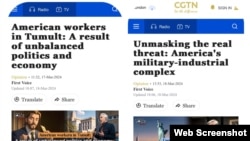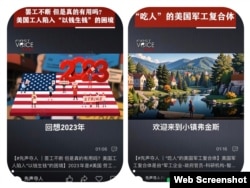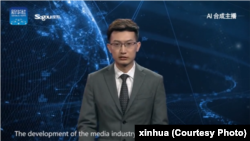Ever seen a badge crack? Well, that’s Uncle Sam’s rep! – A robotic female voice tells a story of America’s imminent demise while the footage shows a U.S.-flag-decorated voter’s badge cracked in the middle.
Launched ahead of the U.S. presidential elections in November and named “A Fractured America,” this cartoon series is a piece of playbook cognitive warfare – a strategy that exploits grievances that exist inside the adversary nation, aiming to radicalize and crash the foundations of its society from within.
While the concept of cognitive warfare existed for decades, the “A Fractured America” cartoon series is a leap forward – its short episodes, a little over a minute long, are created by generative artificial intelligence. The series also marks the first time that the Chinese government has publicly used AI to target the hearts and minds of Americans by implanting the idea of mass riots and civil disobedience.
The series was produced by First Voice – a technologically advanced unit of CGTN, the state-owned China Global Television Network.
The series is a response to “the frequent chaos of America’s democratic disturbances,” CGTN said when introducing the first episode on March 17.
The plot is designed to amplify divisive issues in the United States, such as the cost of healthcare, income inequality, racial justice, immigration and gun control.
First Voice produced the series in English: there is no Mandarin narration in any of the episodes released thus far, with Mandarin subtitles added only to the versions posted on the Chinese social media platform WeChat.
CGTN and First Voice have posted the series mainly on Western social media platforms and on YouTube. That suggests China’s domestic audience is not the primary target of this propaganda project, given that the Chinese government blocks access inside China to YouTube, Western social media platforms and numerous other online resources.
Fabricating reality, the first episode, titled “American workers in Tumult,” features a 2023 nationwide strike in the U.S. rooted in the “structural imbalances in the political and economic landscape.”
The AI narrator says, describing the fictional crisis: “Over 453,000 of them are standing up, signs in hand. From the buzz of the city streets to the quiet surroundings of hotel lobbies, workers from all walks of life are striking out. All these reflect deepening income inequality and workers' disputes in the U.S.”
The second episode, “Unmasking the real threat: America’s military-industrial complex,” targets the U.S. Defense Department, claiming that the military controls all other branches of the U.S. government, the media, academia and think-tanks, with the single agenda of “turning global conflicts into cash.”
Using the same fabricated reality technique as in the first episode, First Voice begins with fictional anti-war protests in a rural town in Virginia, and then closes the episode with animated footage of the Earth exploding. That is followed by the statement, “The real threat isn’t in some distant land. It’s right here, in the U.S.,” while the video shifts to show a panoramic view of the Statue of Liberty.
The third episode, “American Dream or American Mirage?” exploits social and economic problems in the U.S., including the income gap, high inflation and racial inequality.
The episode’s plot is designed to hijack the idea of the “American Dream,” describing it as “decaying.” The episode exaggerates the existing problems and paints the freedoms that come with being American as nothing more than being free to become a drug addict, poor, homeless or unjustly incarcerated.
CGTN is now releasing new episodes of the series daily.
While the first episode had the upper left subtitle saying “AI-generated,” that disappeared from the later episodes.
The series demonstrates how easy it is to use AI for propaganda and to exacerbate pre-existing concerns or fears, Lindsay Gorman, head of the technology and geopolitics team at the German Marshall Fund’s Alliance for Securing Democracy (ASD), told VOA.
“On a technical level, nothing in this video series couldn’t be done using traditional graphic animation techniques, but AI may make it easier to create this content at scale,” she wrote in an email.
Disinformation based on fear is “a central tactic in authoritarians’ efforts for social control,” said Allie Funk, research director for technology and democracy at Freedom House, a Washington, D.C.-based human rights group.
“The affordability and accessibility of generative AI have lowered the barrier of entry to the disinformation market. Anyone with financial or political incentives can use this technology to create false and misleading information at scale,” Funk told VOA.
ASD’s Gorman points out that, apart from producing at scale, AI makes it possible for CGTN to produce this series without significant investments in research and talent that understands American society.
“Generative AI can also aid in creating fluid language for autocratic information manipulation campaigns without the necessity for native-level sophistication, as we see in this series. This capability could democratize the ability to generate realistic and compelling propaganda without exposure to the languages and cultures these regimes wish to denigrate,” she told VOA.
The World Economic Forum said in a report in January that AI-powered misinformation is the world’s biggest short-term threat, highlighting how rapid advances in technology are also creating new problems.
The report’s authors expressed the worry that generative AI such as ChatGPT means that animators no longer need professional knowledge and can easily generate complex animated content. This means that spreading false information no longer requires expensive investment and high human and material costs.
Although the “A Fractured America” series marks the first such use of AI-generated animation, China’s state media began testing the waters a few years ago.
In 2018, Xinhua News Agency introduced two new members of its newsroom: AI anchors who would report “tirelessly” 24/7 from anywhere in the country.
In 2019, the outlet announced that it had created an AI editorial newsroom, “using AI in the editing process” to boost productivity and innovation.
In 2020, Xinhua added the world’s first AI 3D news anchor, able to mimic human voices and gestures in 3D.
Yet in China, information fed to these generative AI tools is often highly censored. While the government is using AI to push out its desired narrative, it requires Chinese creators of generative AI chatbots to follow strict content controls and ensure the “truth accuracy, objectivity and diversity” of the training data.
That means sensitive issues such as Taiwan, Tibet and Tiananmen Square won’t be included.
In its annual Freedom on the Net report, Freedom House said that artificial intelligence is contributing to the decline of global internet freedom. The report determined that China has the world’s worst environment for internet freedom for the ninth consecutive year.
Freedom House’s Allie Funk said these selective training and disinformation campaigns could undermine public trust in democratic processes, incentivize activists to self-censor and drown out independent reporting.
Thus, she stressed, “stronger transparency and independent oversight over the design, testing, use and effects of AI products” are crucial at this point.












